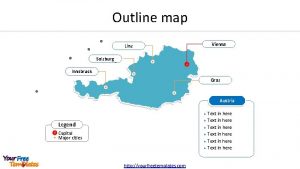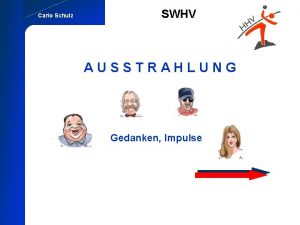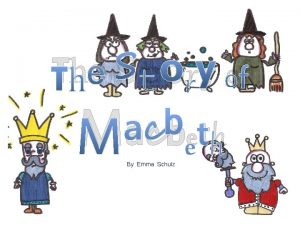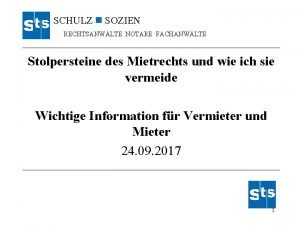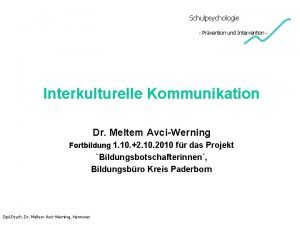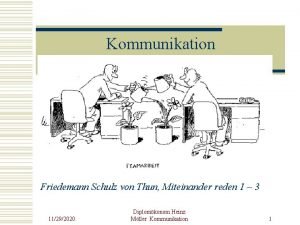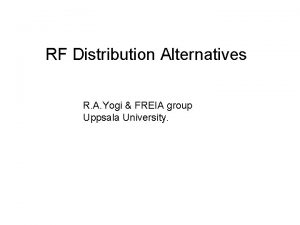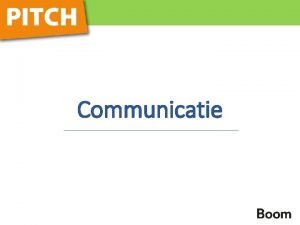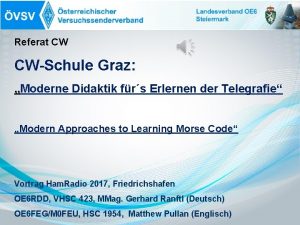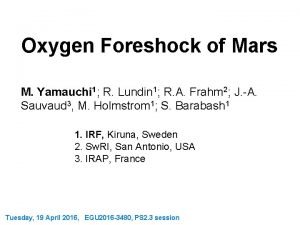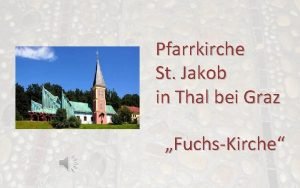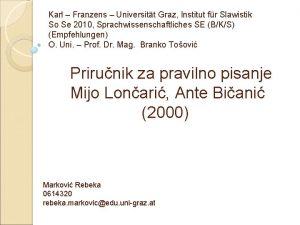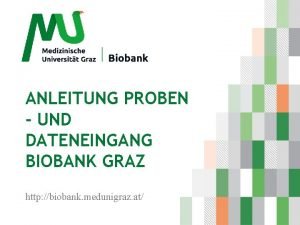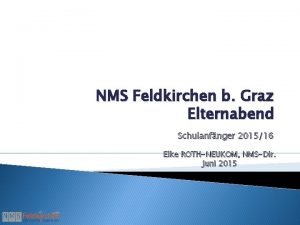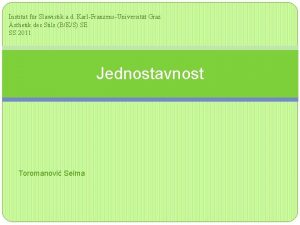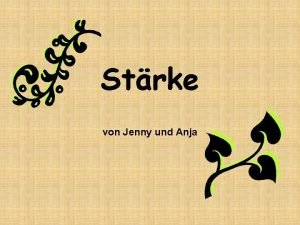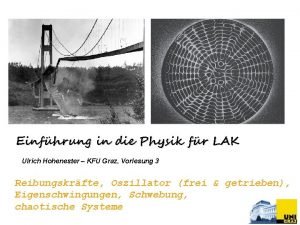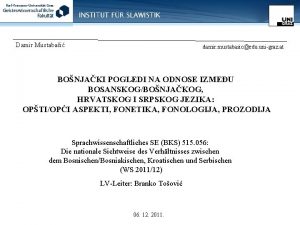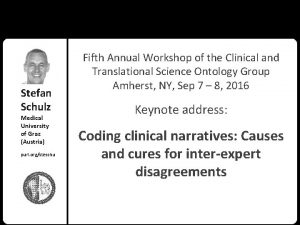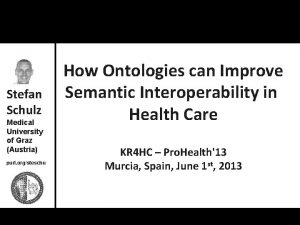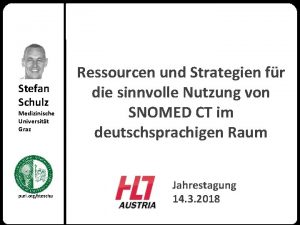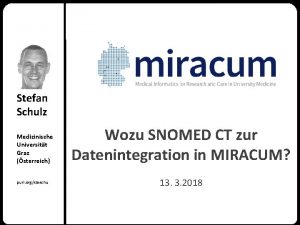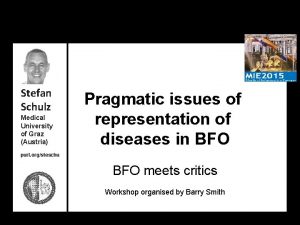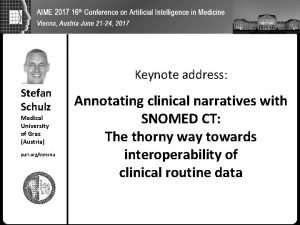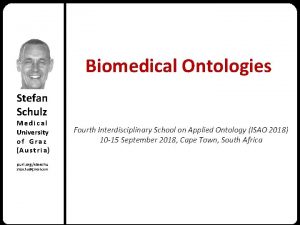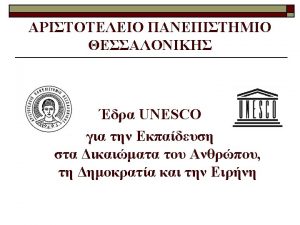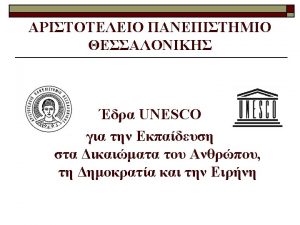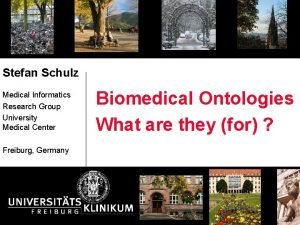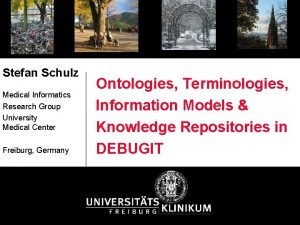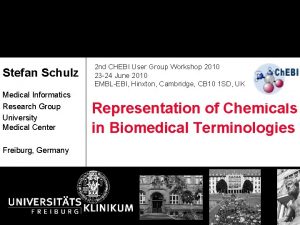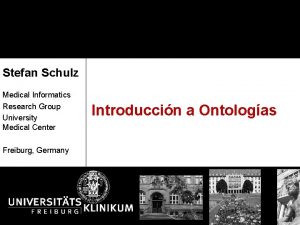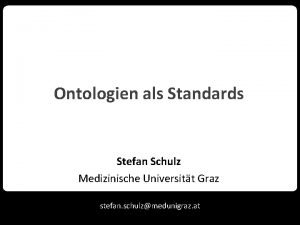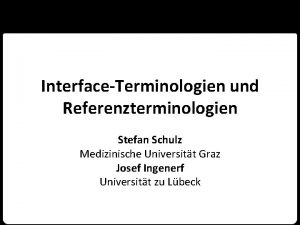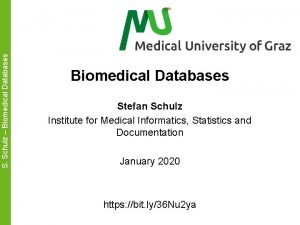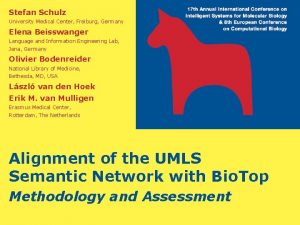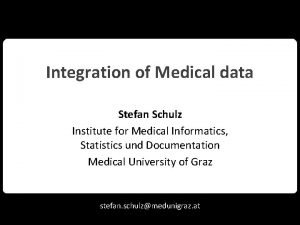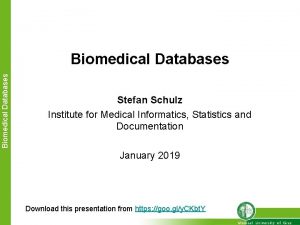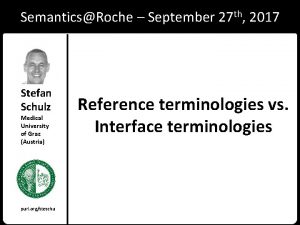Stefan Schulz Medical University of Graz Austria purl









































- Slides: 41

Stefan Schulz Medical University of Graz (Austria) purl. org/steschu Does Medical Image Simulation Require Formal Ontologies? VIP – Virtual Imaging Workshop Lyon, France, Dec 14 th, 2012

What are (formal) Ontologies?

What are (formal) Ontologies? § Computer science view § Ontologies are purpose-oriented formal models of meaning (conceptualizations) § Cognitive / linguistic view § Ontologies are concept systems or systems of semantic reference (no clear distinction from thesauri) § Also adopted by parts of the Semantic Web community § Philosophy view (scientific realism) § Ontology is the study of what there is § Formal Ontologies give precise mathematical formulations of the properties and relations of certain entities. Quine O. On what there is. In: Gibson R. Quintessence - Basic Readings from the Philosophy of W. V. Quine. Cambridge: Belknap Press, Harvard University, 2004. Schulz S, Stenzhorn H, Boeker M, Smith B: Strengths and limitations of formal ontologies in the biomedical domain. RECIIS - Electronic Journal in Communication, Information and Innovation in Health, 2009; 3 (1): 31 -45:

Formal ontology in a nutshell § § § Formal ontology = logic based ontology Description logics: subset of first order logic Common standard: OWL (Ontology Web Language) Ontologies are taxonomies of classes Ontologies can define classes in terms of (Aristotelian) definitions Subclass (aka is-a): A sub. Class. Of B iff a: A(a) B(a) Vertebrate sub. Class. Of Primate sub. Class. Of Equivalence: X equivalent to Y and some r Z iff x: X(x) Y(x) z: C(z) r(x, z) Homo Sapiens Primate sub. Class. Of Vertebrate equivalent. To Animal and has. Part some Vertebra

Taxonomy as Venn diagram Every human is a primate, every primate is a vertebrate Tristan Class: Vertebrate Class: Primate Transitivity: Every human is a vertebrate Class: Homo S. Bernard Washoe Stefan Human sub. Class. Of Primate Koko Bobo

Doing taxonomy right a: A(a) B(a) Test : • there is no neoplasms that is not an oncology • there is no prostate that is not a neoplasm • there is no oncology that is not a clinical medicine

Doing taxonomy right a: A(a) B(a) Test : • oncology is an instance of a medical discipline • there is no prostate neoplasm that is not a neoplasm Labelling ! http: //en. wikipedia. org/wiki/Onto. Clean Schober D, Smith B, Lewis SE, Kusnierczyk W, Lomax J, Mungall C, Taylor CF, Rocca-Serra P, Sansone SA. Survey-based naming conventions for use in OBO Foundry ontology development. BMC Bioinformatics. 2009 Apr 27; 10: 125. doi: 10. 1186/1471 -2105 -10 -125.

Formal ontology in a nutshell § § § Formal ontology = logic based ontology Description logics: subset of first order logic Common standard: OWL (Ontology Web Language) Ontologies are taxonomies of classes Ontologies can define classes in terms of (Aristotelian) definitions Subclass (aka is-a): A sub. Class. Of B iff a: A(a) B(a) Vertebrate sub. Class. Of Primate sub. Class. Of Equivalence: X equivalent to Y and some r Z iff x: X(x) Y(x) z: C(z) r(x, z) Homo Sapiens Primate sub. Class. Of Vertebrate equivalent. To Animal and has. Part some Vertebra

Aristotelian Definitions: Genus proximum and differentia specifica Viral Hepatitis located in Liver Viral Infection Viral. Hepatitis equivalent. To Viral. Infection and located. In Liver Test : • There is no viral hepatitis that is not located in a liver • There in no viral hepatitis that is not a viral infection

Ontological Commitment • Which are the instances? • Does the label tell us what is meant? • Is there an implicit context? Test : • There is no neoplasm in both lungs that is not a neoplasm in the left lung • There is no varicose vein in the lower limb that is not a chronic peripheral venous insufficiency • There is no patient with neoplasm in both lungs that is not a patient with the neoplasm in the left lung • There is no patient with varicose lower limb veins that is not a patient with a chronic peripheral venous insufficiency

Upper level ontologies: partition of the domain into disjoint and exhaustive categories Process Quality Information Object Material Object • Upper level ontologies enforce a strict categorization • Constraints on upper-level categories • Upper level ontology for the biomedical domain Bio. Top http: //purl. org/biotop Disposition

How formal ontologies challenge human cognition § Built around taxonomies of classes § ATTENTION: our intuitive way of hierarchically organize terms is not strictly taxonomic § State what is true for all individual members of a class (instances of a type) § Requires to distinguish between classes and individuals § ATTENTION: human language is often misleading, e. g. Lyon is a big city vs. The liver is a big organ § Individuals commit to upper-level categories § ATTENTION: our thinking fuses mutually dependent entities that belong to different categories, e. g. Cancer (growth process vs. mass of malignant tissue) § Upper level categories should be made explicit § Explicit upper level ontology – common understanding § Implicit upper level ontology of each of us – misunderstanding

What formal ontology is not § Ontology Knowledge representation § "There are very few interesting items of knowledge that are truly ontological in this strict sense" (Alan Rector) § antinomy: ὄντος (being) vs. ἐπιστήμη (knowledge) § Ontology is not appropriate for § Default knowledge § "The hand has 5 fingers" (unless otherwise stated) § Probabilistic knowledge § Mesothelioma is a rare cancer § Contingent knowledge § Aspirin prevents myocardial infarction § Jaundice is a typical symptom of hepatitis

Why formal ontology at all ? ? § Formal definitions create maximum consensus on the meaning of terms § Ontologies as standards § Reusable terms and axioms § Formal axioms encode statements about what is considered to be universally true in a domain § in contrast to knowledge proper § Formal axioms permit logic-based reasoning § Consistency checking § New entailments § Equivalence of syntactically heterogeneous expressions can be computed: semantically interoperable systems

Ontologies in life sciences and health care

Ontologies in life sciences and health care § Bottom-up ontology development: OBO (Open biomedical Ontologies) Foundry § Top-down ontology development: SNOMED CT (Systematized Nomenclature of Medicine – Clinical terms)

OBO Foundry: Orthogonality by Upper-level, and Granularity divisions RELATION TO TIME CONTINUANT INDEPENDENT OCCURRENT DEPENDENT GRANULARITY ORGAN AND ORGANISM CELL AND CELLULAR COMPONENT MOLECULE Organism Anatomical Organ (NCBI Entity Function Taxonomy) (FMA, CARO) (FMP, CPRO) Cell (CL) Cellular Component (FMA, GO) Molecule (Ch. EBI, SO, Rna. O, Pr. O) Phenotypic Quality (Pa. TO) Biological Process (GO) Cellular Function (GO) Molecular Process (GO) Smith, B. ; Ashburner, M. ; Rosse, C. ; Bard, J. ; Bug, W. ; Ceusters, W. ; Goldberg, L. J. ; Eilbeck, K. et al. (2007). "The OBO Foundry: Coordinated evolution of ontologies to support biomedical data integration". Nature Biotechnology 25 (11): 1251– 1255. doi: 10. 1038/nbt 1346

The OBO Foundry § Collaborative bottom up initiative, driven by the success of the Gene Ontology § Rooted in upper ontologies (BFO + RO) § Goal of creating a suite of orthogonal interoperable reference ontologies in the biomedical domain § Moving from semi-formal OBO syntax to OWL-DL § Cross-ontology definitional axioms: § Calcitonin secreting cell (Cell Ontology) can be defined as a Secretory cell which secretes Calcitonin (Ch. EBI) § Heart development (Gene Ontology) can be defined as a Developmental process which has Heart (FMA) as participant Smith, B. ; Ashburner, M. ; Rosse, C. ; Bard, J. ; Bug, W. ; Ceusters, W. ; Goldberg, L. J. ; Eilbeck, K. et al. (2007). "The OBO Foundry: Coordinated evolution of ontologies to support biomedical data integration". Nature Biotechnology 25 (11): 1251– 1255. doi: 10. 1038/nbt 1346

SNOMED CT (Systematized Nomenclature of Medicine - Clinical Terms) http: //www. ihtsdo. org/

SNOMED CT - clinical terminology with ontological foundations § Terminology for clinical data covering diseases, findings, procedures, organisms, substances etc. § 311, 000 concepts, connected by 1, 360, 000 relational expressions § Definitions with DL axioms § Promoted as an international terminological standard"

SNOMED CT: Terminology + Ontology Concepts (representational units) DL Axioms Terms http: //viw 2. vetmed. vt. edu/sct/menu. cfm

Bioportal – repository for biomedical ontologies Submit your ontology to http: //bioportal. bioontology. org

Formal ontologies and beyond… http: //bioportal. bioontology. org

Alternative to formal ontologies: INFORMAL terminologies / thesauri

Alternative to formal ontologies: INFORMAL terminologies / thesauri § Group together words / terms according to similarity in meaning § Basic relations: § Synonymy § Broader / Narrower (ordering relations) § § § Concept = Group of (quasi)synonyms Multiple hierarchies Mainly designed for retrieval Text definitions / explanations (scope notes) if required No formal semantics Freitas F, Schulz S, Moraes E: Survey of current terminologies and ontologies in biology and medicine. RECIIS - Electronic Journal in Communication, Information and Innovation in Health, 2009; 3 (1): 7 -18: http: //dx. doi. org/10. 3395/reciis. v 3 i 1. 239 en

Me. SH - Medical Subject Headings http: //www. nlm. nih. gov/mesh/


Example: Medical Subject Headings (Me. SH) Literature search: monoclonal antibodies and cancer therapy Me. SH terms

"Nontologies" § Use OWL syntax, which should not be interpreted according to description logics semantics § Formal reasoning would lead to incorrect entailments § Examples: NCI thesaurus, Radlex § Many other ontologies contain problematic axioms that contradict the intended meaning § Example (NCI thesaurus): Calcium-Activated_Chloride_Channel-2 sub. Class. Of Gene_Product_Expressed_In_Tissue some Lung and Gene_Product_Expressed_In_Tissue some Mammary_Gland Gene_Product_Expressed_In_Tissue some Trachea Ureter_Small_Cell_Carcinoma subclass. Of Disease_May_Have_Finding some Pain Schulz S, Schober S, Tudose I, Stenzhorn H: The Pitfalls of Thesaurus Ontologization – the Case of the NCI Thesaurus. AMIA Annu Symp Proc, 2010: 727 -731

(N)ontologies of interest for imaging § Radlex § 24800 classes covering anatomy, procedures, diseases, substances, devices, relevant for radiologic imaging § all classes are also individuals (punning) § Relations ('is a', 'part of') asserted are at the level of individuals § On classes no other axioms than subclass axioms § Foundational model of anatomy § Complete model: Protégé Frames (no formal semantics) Parts of it available as OWL § All assertions at class level § Logical entailments only true for "canonical" anatomy § SNOMED CT

Challenges of "correct" ontology for image representation including simulation § Same terms (e. g. "cardiac motion") can be used for different things 1. A real cardiac motion in a patient (process) 2. Part of an image (information entity) that represents a real cardiac motion 3. A simulation artifact (information entity), which does not refer to any specific cardiac motion 4. The "concept" cardiac motion (cognitive entity) § If you prefer 4. or if the distinction between 1. – 4. does not matter, then you shouldn't use formal ontologies

Where ontologies or thesauri are sufficient § Provision of controlled terms § Good text definitions should be available § Hierarchy expansion for retrieval § hierarchical links at the level of broader term / narrower terms § is-a is narrower than § part-of is narrower than § "Hand-crafted" inference rules § no use of description logics classifiers § Possible standard SKOS http: //www. w 3. org/2004/02/skos/intro

Own experiences with ontologies in large projects § EU funded projects with multiple partners 1. @neur. IST: Data integration (clinical, genomic, simulation) on cerebral aneurysms 2. Debug. IT: Decision support system for infectious diseases 3. Semantic. Health. Net: Semantic interoperability between heterogeneous semantic representations in the EHR § Experiences: § in 1. and 2. much effort put in formal ontology § Mostly used as a controlled vocabulary (1. ) § DL reasoning only for computing inferred ontology, which then used with production rules § 3. Formal foundation seems fundamental to reach the interoperability goal. However, intellectual input considerable and scalability still open

Current state of the art of Applied Ontology as a discipline

Current state of the art of Applied Ontology as a discipline § § Applied Ontology – still emerging discipline Prevalence of makeshift ontology artifacts Ontology engineering required to be more principled Necessary resources § § § Standards (Semantic Web – OWL ) Good practice guidelines (e. g. Good. OD Guideline) Quality management Best-of-breed examples Industry-standard tools § Editors § Reasoners http: //www. iph. uni-rostock. de/Good. OD-Guideline. 1299. 0. html

Current state of the art of Applied Ontology as a discipline http: //www. iph. uni-rostock. de/Good. OD-Guideline. 1299. 0. html

Current state of the art of Applied Ontology as a discipline § § Applied Ontology – still emerging discipline Prevalence of makeshift ontology artifacts Ontology engineering required to be more principled Necessary resources § § § Standards (Semantic Web – OWL ) Good practice guidelines (e. g. Good. OD Guideline) Quality management Best-of-breed examples Industry-standard tools § Editors § Reasoners http: //www. iph. uni-rostock. de/Good. OD-Guideline. 1299. 0. html

Decision on using formal ontology in life science research projects § Functional requirements § § § § Controlled terminology Query expansion for retrieval Precise definitions of terms Precise classification of domain entities Reasoning to establish semantic equivalence Representation of contingent knowledge Default reasoning Probabilistic reasoning

Decision matrix Thesauri / Ontologies / KR formalism ri u sa the y o g o l nto Controlled domain language x Query expansion for retrieval x x Precise definitions of terms x x Precise classification of domain entities x x Reasoning to establish semantic equivalence x x Representation of contingent knowledge x x x Non-monotonic reasoning x x x Probabilistic reasoning x x x KR

Further readings

Ontology on the Web § Description Logics: http: //dl. kr. org/ § Protégé: http: //protege. stanford. edu/ § Bioontology: http: //www. bioontology. ch/ § Buffalo Ontology Site: http: //ontology. buffalo. edu/smith/ § OBO Foundry: http: //obofoundry. org/ § Bioportal: http: //bioportal. bioontology. org/ § SNOMED CT: http: //www. ihtsdo. org/snomed-ct/ http: //terminology. vetmed. vt. edu/sct/menu. cfm § CO-ODE (Pizza ontology): http: //www. co-ode. org/ § Good. OD Guideline: http: //www. iph. uni-rostock. de/Good. ODGuideline. 1299. 0. html
 Austria outline map
Austria outline map Monte schulz
Monte schulz Kelly m schulz
Kelly m schulz Antonietta portulano
Antonietta portulano Carlo schulz
Carlo schulz Emma schulz
Emma schulz Traueranzeige sven schulz greifswald
Traueranzeige sven schulz greifswald Valerie schulz
Valerie schulz Schulz sozien
Schulz sozien 4 seiten einer nachricht
4 seiten einer nachricht Model komunikacije
Model komunikacije Selbstoffenbarungsohr
Selbstoffenbarungsohr Wolfgang schulz döbling
Wolfgang schulz döbling Bruno schulz art
Bruno schulz art Yogi distribution
Yogi distribution Yogi schulz
Yogi schulz Escuela nacional preparatoria 8
Escuela nacional preparatoria 8 Zbmo model
Zbmo model Sokrates web tirol
Sokrates web tirol Cw schule graz
Cw schule graz Sandra hummel uni graz
Sandra hummel uni graz Itat graz
Itat graz Yamauchi graz
Yamauchi graz Arbeitsmedizinische untersuchung fit2work
Arbeitsmedizinische untersuchung fit2work Checkin tu graz
Checkin tu graz Kirche thal bei graz
Kirche thal bei graz Kinderschutzzentrum
Kinderschutzzentrum Slawistik graz
Slawistik graz Dreihackengasse
Dreihackengasse Nada therapie
Nada therapie Kosten fahrzeugbeschriftung
Kosten fahrzeugbeschriftung Biobank graz
Biobank graz Nms feldkirchen
Nms feldkirchen Razgovorni stil primjer
Razgovorni stil primjer Sz bauwerksabdichtung graz
Sz bauwerksabdichtung graz Berblick
Berblick Efkon graz
Efkon graz Doppelpendel chaotisches verhalten
Doppelpendel chaotisches verhalten Institut für slawistik graz
Institut für slawistik graz Hodza u graz muhamed
Hodza u graz muhamed Was austria hungary a country
Was austria hungary a country Composer born in salzburg
Composer born in salzburg
